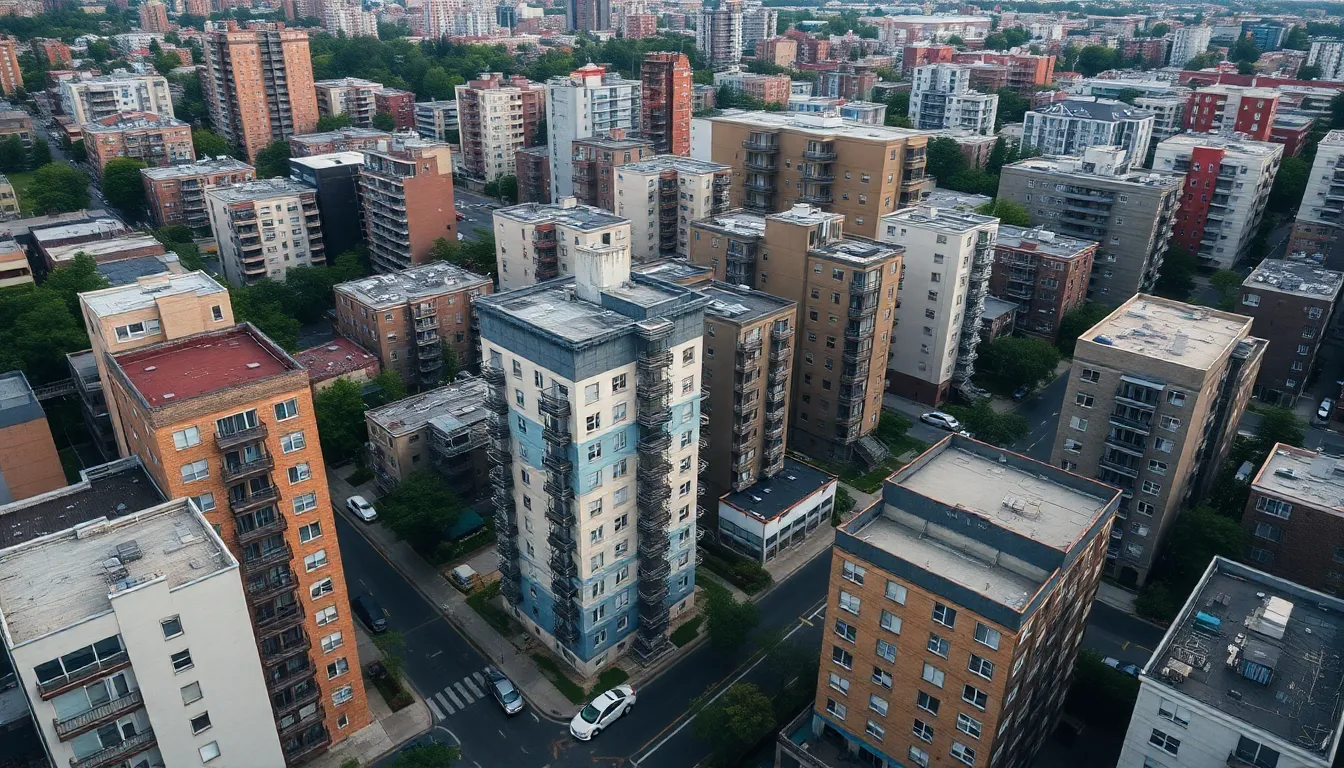As inflation creeps up like that one friend who always shows up uninvited, many are feeling the pinch in their wallets. Renting during these times can feel like trying to find a unicorn in a haystack—frustrating and a bit magical if you get it right. With prices soaring faster than a cat on a laser pointer, navigating the rental market requires strategy and a sense of humor.
But fear not, brave renters! With a little savvy and some clever tips, it’s possible to secure your dream space without sacrificing your sanity. This article dives into the ins and outs of renting in an inflationary world, helping you dodge those pesky price hikes while still finding a place you can call home. So grab your favorite snack and let’s unravel the mysteries of renting during inflation—because who said saving money couldn’t be entertaining?
Table of Contents
ToggleOverview of Renting During Inflation
Renting during inflation presents distinct challenges that require strategic planning. Multiple factors contribute to rising rental prices, including increased demand and limited housing supply. Renters often find themselves competing for a shrinking pool of affordable units as inflation pushes costs higher.
Understanding market trends becomes essential for anyone navigating this landscape. Data from real estate platforms reveals that in many urban areas, rent prices surged by an average of 5-10% over the past year. Such increases can strain budgets, making it crucial for renters to assess their financial situations.
In times of inflation, flexibility proves valuable for renters. Seeking properties in less popular neighborhoods often yields lower rental rates without sacrificing quality. Budgeting for additional expenses, like utilities and maintenance, ensures comprehensive financial planning.
Negotiating lease terms also offers an opportunity to secure better deals. Landlords may be open to conversations about reducing rent increases or extending lease durations. Understanding local laws on rent control can further empower renters to advocate for more favorable conditions.
Examples abound of renters utilizing creative approaches to save money. Room-sharing arrangements can cut costs significantly, while longer lease terms might offer stability against sudden price hikes. Adopting these strategies can transform the renting experience into a manageable endeavor amid inflationary pressures.
Impact of Inflation on Rental Prices
Inflation significantly affects rental prices, pushing them higher and creating challenges for renters. Understanding these changes helps navigate the rental market more effectively.
Historical Trends in Rental Prices
Historically, rental prices exhibit a steady increase, particularly evident during inflationary periods. Data shows that rental costs surged by an average of 5-10% over the past year in many urban areas. Past trends highlight that economic downturns often correlate with slower rental growth, while recovery phases lead to accelerated price hikes. During inflationary times, landlords frequently adjust rents to keep pace with rising costs. This historical context emphasizes the importance of strategic planning for renters in today’s climate.
Regional Variations in Rent Increases
Rental price increases vary significantly by region, influenced by local economic conditions and demand. In some urban centers, rents have escalated by up to 15%, while suburban areas may see more modest increases of around 3-5%. Factors such as employment rates, population growth, and housing availability play crucial roles in these variations. Understanding regional differences aids renters in finding more affordable options. Identifying less competitive markets may provide opportunities for budget-friendly housing arrangements during inflationary times.
Strategies for Tenants
Navigating the rental market during inflation requires effective strategies. Tenants can adopt specific approaches to alleviate financial pressures.
Negotiating Rent with Landlords
Rent negotiations offer a path to affordability. Start discussions by reviewing current market rates to establish a reasonable offer. Highlighting personal circumstances, such as good rental history, strengthens negotiating power. Offering to sign a longer lease may lead to a better rate. Landlords often appreciate stability, making this a mutually beneficial arrangement. Additionally, being open to deferred rental increases can also help secure a lower current rate. Terms that involve trade-offs, such as agreeing to maintain the property or handle minor repairs, can further enhance negotiations.
Understanding Lease Agreements
Comprehending lease agreements remains vital for tenants. Focus on key aspects like payment terms, renewal clauses, and maintenance responsibilities. Read the fine print to identify hidden fees or conditions that may affect costs. Know the terms of rent hikes, especially in inflationary periods. Some leases may specify how often rent increases can occur and by what percentage. Such knowledge equips tenants to challenge unreasonable increases. Recognizing local rent control laws also empowers renters in negotiations. Familiarity with eviction procedures ensures that tenants understand their rights and responsibilities.
Advantages of Renting During Inflation
Renting during periods of inflation offers distinct benefits for tenants. Flexibility forms one of the key advantages. Tenants can relocate easily without the burden of long-term mortgage commitments, enabling them to adapt to changing economic circumstances.
Lower upfront costs represent another significant benefit. Many rental properties require smaller initial investments compared to purchasing a home. This aspect allows for better cash flow management, particularly in uncertain financial climates.
Maintaining flexibility during inflation becomes crucial. Renters can choose to live in various neighborhoods, aligning their living situation with their financial capabilities. Choosing less trendy areas often leads to lower rental prices, presenting further savings opportunities.
Negotiation presents a powerful tool for renters. Understanding local rental markets leads to informed discussions about rent prices. Many landlords prefer occupying properties rather than leaving them vacant, providing tenants with leverage in negotiations.
Limited maintenance responsibilities remain a notable advantage. Renters typically aren’t liable for major repairs, allowing them to allocate funds elsewhere. This setup can relieve financial stress as inflation raises overall living costs.
The potential for stability also exists. Locking in a lease at a fixed rate provides predictability in budgeting. Renters secure a consistent housing cost that does not increase until the lease ends, which aids in financial planning.
Location availability can expand during inflation. Landlords often face difficulties filling vacancies, prompting them to consider lower offers. This scenario allows renters a chance to explore a broader range of properties that might otherwise be out of reach.
These advantages highlight why renting during inflation offers a strategic approach for those navigating tight housing markets.
Challenges Faced by Renters
Renters face various challenges during inflationary periods, primarily due to rising costs and limited choices.
Budgeting for Rising Costs
Budgeting for higher expenses becomes essential when rent increases by an average of 5-10%. Renters must reassess their financial situations and adjust their budgets accordingly. Evaluating discretionary spending helps prioritize essential costs. Seeking additional sources of income, such as part-time jobs or gigs, can supplement diminished budgets. Identifying necessary expenses, like utilities and groceries, ensures funds are allocated effectively. It’s prudent to save extra money to cover unexpected increases in rent. Renters may consider cutting back on non-essential items to accommodate rising rental prices.
Limited Rental Options
Limited rental options emerge as supply struggles to meet demand in many urban areas. Many properties face stiff competition, leading to quick turnover rates. Renters often find themselves bidding against others for the same apartment, exacerbating the challenge. In cities experiencing significant hikes, like those reaching up to 15%, choices narrow further. Exploring less popular neighborhoods can sometimes yield more affordable options, but those come with trade-offs. Sacrificing certain amenities remains a possibility for those needing budget-friendly solutions. Resources like online rental platforms can provide some insights into available listings and trends.
Conclusion
Navigating the rental market during inflation can feel daunting but it’s not insurmountable. With the right strategies and a flexible mindset, renters can find manageable solutions even in challenging conditions. Embracing creativity in budgeting and negotiation can lead to more favorable lease terms and lower costs.
Understanding regional trends and being open to exploring different neighborhoods can unlock opportunities that align with financial goals. Ultimately, renting during inflation offers unique advantages that can help individuals maintain stability while adapting to changing economic landscapes. By staying informed and proactive, renters can turn challenges into opportunities for a more satisfying living experience.



